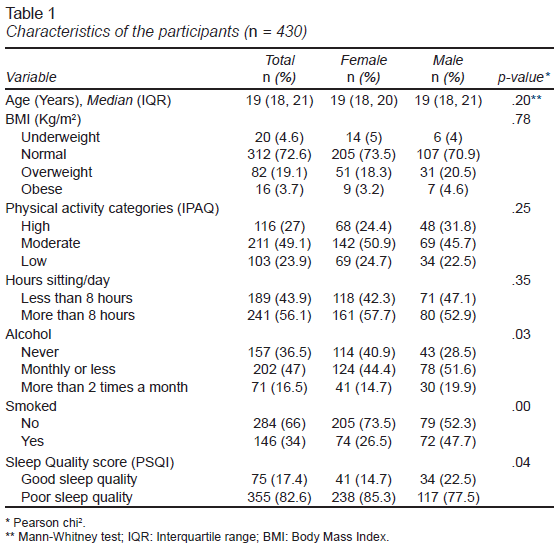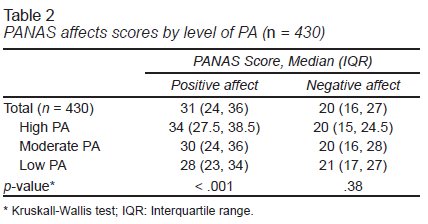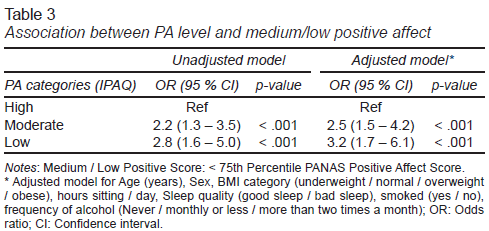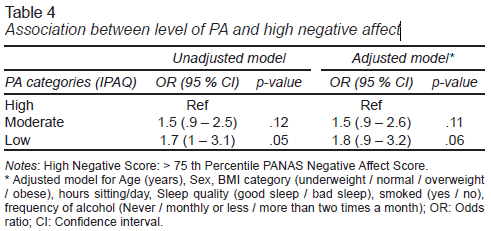INTRODUCTION
The social distancing measures imposed since 2020 by the coronavirus disease 2019 (COVID-19) pandemic have negatively impacted the physical and mental health of the world population (Stanton et al., 2020). Confinement and restrictions on mobility changed routines, PA levels decreased (vigorous, moderate, and walking), and daily sitting time increased by more than 28% (Ammar et al., 2020). The daily step count decreased worldwide after COVID-19 was declared a global pandemic (Tison et al., 2020). However, before the pandemic, PA reports on college students already showed low adherence to recommendations globally (Blake, Stanulewicz, & Mcgill, 2017). Latin America showed the same trend, especially among women (Concha-Cisternas et al., 2018). Physical inactivity is the fourth leading risk factor for mortality worldwide (6% of deaths globally) and is directly associated with overweight and obesity (Bull et al., 2020).
The association between PA and mental health has been widely explained (Lubans et al., 2016). During the pandemic, negative emotions and cognitive distress were evident, which appeared to be lower in people who engaged in regular PA (Zhang, Zhang, Ma, & Di, 2020). Previous studies have shown that PA reduces anxiety and stress symptoms and increases well-being (Mikkelsen, Stojanovska, Polenakovic, Bosevski, & Apostolopoulos, 2017). Emotional well-being refers to a state of mind that allows people to balance all aspects of life: physical, mental, emotional, and spiritual. This balance facilitates coping with pressures, directing decision-making toward achieving goals through a dialogue between needs and desires (Asún, Palma, Aceituno, & Duarte, 2021). Likewise, emotional states promote “healthy” and “unhealthy” behaviors and can support the initiation and maintenance of a PA routine (Schultchen et al., 2019). Positive affect can facilitate the conversion of intentions to practice PA into reality and increase its frequency and duration (Ries & Sevillano, 2011).
The evolution of the pandemic has allowed the implementation of a hybrid educational model with face-to-face and online activities that mean fewer restrictions on mobility (Contreras et al., 2022). In this sense, it is essential to continue exploring the psychological manifestations and the impact on lifestyles (PA, sleep quality), in the context of reopening face-to-face spaces, especially in young adults considered a risk group for mental disorders (Auerbach et al., 2016). Thus, this research aims to describe the relationship between affect (positive and negative) and PA in college students during the COVID-19 pandemic.
METHOD
Study design
This study is a cross-sectional survey. The report was made following the STROBE guidelines for cross-sectional studies.
Subjects
An electronic survey was conducted among health sciences students from three universities in Mexico and Colombia between August 2021 and March 2022. The inclusion criteria were the following: a) regular first-year Physiotherapy students from the Universidad Nacional Autónoma de México, Nursing from the Universidad Javeriana and Medicine from the Fundación Universitaria San Martín; b) both sexes. The sampling was non-probabilistic; there were no elimination criteria, in addition to not completing the entire questionnaire.
Due to epidemiological restrictions, the students attended their academic activities in a mixed mode (live/classroom or online), so the survey was sent to them electronically through Google Forms. It was impossible to obtain written informed consent, so participants were provided with an electronic form before participating in the survey. Anonymized survey data was then entered into a database following the Privacy Policy of the participating institutions. Data on age, sex, weight, height, alcohol, smoking, PANAS Index, Pittsburgh Sleep Quality Index (PSQI), and the seven items of the short version of the International Physical Activity Questionnaire (IPAQ-S) were collected.
Measurements
Physical Activity (PA)
PA was measured using the short version of the International Physical Activity Questionnaire (IPAQ-S). This questionnaire has been widely used and validated in at least 12 countries, showing adequate concurrent and criterion validity (Craig et al., 2003). This instrument provided information on the time spent walking in vigorous- and moderate-intensity and sedentary activity. Total weekly PA expressed in METS (MET min/week) was calculated as duration × frequency per week × MET intensity. MET intensity was estimated based on the official IPAQ guidelines for adults aged 18-65: vigorous PA = 8.0 METS, moderate PA = 4.0 METS, and walking = 3.3 METS. PA was defined into three categories (low, moderate, and high; IPAQ, 2002). In addition, we added an item to explore the perception of change between the level of PA before and during the pandemic (Do you think your level of PA before and during the COVID-19 pandemic decreased, did not change or increased?).
Positive and Negative Affect
Positive and negative affect were assessed using the PANAS Index. This tool includes 20 items, ten of which evaluate positive affect and ten negative affect. The items consist of words that describe different feelings and emotions. The participant rates these emotions according to the degree to which they experience them on a five-point Likert-type scale, where one means “very little or not at all” and five means “extremely.” High positive affect is associated with a state of well-being, joy, and pleasurable engagement. In opposition, negative affect is characterized by discomfort, frustration, and lethargy (Watson, Clark, & Tellegen, 1988).
The Spanish version of this scale has shown high internal consistency, with alphas from .85 to .90 for positive affect and .81 to .85 for negative affect (González & Valdez, 2015).
Sleep Quality
Sleep quality was assessed using the Pittsburgh Sleep Quality Index (PSQI). This self-administered questionnaire includes seven sleep components: subjective sleep quality, latency, duration, efficiency, disturbance, use of sleep medications, and daytime dysfunction. The score of components ranges from 0 to 3, and the total score varies from 0 (no difficulty) to 21 (problems in all areas). A higher score indicates poorer sleep quality with a cut-off point of 5 to distinguish “good sleep quality” from “poor sleep quality” (Buysse, Reynolds, Monk, Berman, & Kupfer, 1989).
This scale has been widely used in the clinical and research area and was validated in a Latin American population older than 18 years with an adequate reliability coefficient (.78; Escobar-Córdoba & Eslava-Schmalbach, 2005) and significant correlation coefficients (.53 to .77) between the components and the total score (Jiménez-Genchi, Monteverde-Maldonado, Nenclares-Portocarrero, Esquivel-Adame, & de la Vega-Pacheco, 2008).
Statistical analysis
Quantitative variables were presented according to their distribution, as mean ± standard deviation (SD) or median (interquartile range), and qualitative variables by absolute and relative frequencies. A logistic regression model was used to explore the association between PA and the probability of having a medium/low positive affect score or a high negative affect score (the highest tertile compared to the middle and low tertiles combined), following the methodology of Pasco et al. (2011). The covariates were gender, Body Mass Index (BMI), hours spent sitting in a day, sleep quality, smoking, and alcohol consumption, which were previously reported in other studies (McMahon et al., 2017). A 95% CI and p ≤ .05 were considered statistically significant. Data were analyzed in Stata version 14 (Stata Corp, College Station, Tex, USA).
Ethical considerations
The protocol was approved by the Ethics and Research Committees of the Hospital Infantil de México Federico Gómez (HIM-2021-008).
RESULTS
The final analysis included 430 participants between 16 and 40 years, and 64.9% were female. The response rate was 73% among students who were invited to participate.
The characteristics of the population are shown in Table 1. It was observed that most participants were in a normal BMI category (72.6%) and performed moderate PA, with no differences between sex. However, women reported sitting more than eight hours per day more frequently. Regarding the PA change after the pandemic’s onset, 59.8% of participants considered that their PA level decreased, and only 24.4% reported that it increased. The remaining 15.8% reported that it did not change.
Additionally, it was observed that smoking and alcohol were higher in men than women, while poor sleep quality was higher in women.
The positive affect score was higher for more physically active students (p < .001). In negative affect, no statistically significant differences were observed between PA categories (Table 2).
Logistic regression results showed that PA was associated with positive affect. The adjusted model showed that people who perform moderate PA are more likely to have a medium/low score of positive affect than those who perform high PA (OR = 2.5; 95% CI [1.5, 4.2]; p < .001). The effect increased in participants performing low PA (OR = 3.2; 95% CI [1.7, 6.1]; p < .001; Table 3). We performed the analysis adjusting for the type of university (public or private) the students belong to, and the coefficients remain similar (data not shown).
No significant association was observed between PA with negative affect (p > .05; Table 4).
DISCUSSION AND CONCLUSION
This result suggests that there is a trend for college students to express fewer positive emotions when they perform less PA. This association was independent of the hours of sitting per day, gender, BMI, age, sleep quality, smoking, and alcohol consumption habits. These findings are consistent with previous studies showing that people who practice some sport or have a higher level of PA obtain better physical and psychological benefits (Duclos-Bastías, Vallejo-Reyes, Giakoni-Ramírez, & Parra-Camacho, 2021).
The participants’ sociodemographic characteristics were similar to other research, with a predominance of the female gender, age close to 19 years, normal nutritional status, and poor sleep quality (Fennell, Eremus, Puyana, & Sañudo, 2022).
However, unlike what Salgado Espinosa and Cepeda-Gaytan (2021) reported, whose participants registered an increase in PA during the pandemic, our study showed the opposite. The rigor of social distancing and isolation was different worldwide, so students’ perceived barriers to PA might vary (Miguel Román, 2020). Local circumstances due to the closure of recreational facilities, restrictions on outdoor activities, and government guidelines and regulations particular to each country were determinants (Bielec & Omelan, 2022).
We found that positive affect scores in our sample appear to be higher than those reported in earlier stages of the pandemic in similar age populations (Markofski, Jennings, Hodgman, Warren, & LaVoy, 2022). This makes evident the adaptability of emotional states to contexts (Cano-Vindel & Miguel-Tobal, 2001), considering that our study was conducted late in the pandemic when knowledge about the virus and the beginning of the vaccination process reduced mobility restrictions worldwide.
Concerning negative affect, we did not observe an association with PA. A study conducted during the first months of the COVID-19 pandemic in US children showed that sedentary behaviors and screen time were positively correlated with negative affect (p < .05, p < .01, respectively; Alves, Yunker, DeFendis, Xiang, & Page, 2020). However, a Brazilian study reported that during confinement and at the onset of the pandemic, people who began exercising during the quarantine period more frequently reported negative emotions. This finding suggests that the benefits of PA on mental health can only be observed with consistent, planned, and directed PA routines; otherwise, it could become an additional stressor that exacerbates negative emotions (Marques de Abreu, de Souza, Viana-Meireles, Landeira-Fernandez, & Filgueiras., 2022).
Evidence suggests a U-shaped relationship between PA and some indicators of negative affect, such as anxiety and depression, in which insufficient or excessive PA is associated with more negative emotions (Zhang et al., 2020). Some recommendations suggest an average of 60 min of moderate to vigorous intensity daily PA to generate visible health benefits (Wicker & Frick, 2017). However, it is still challenging to determine the optimal dose associated with better outcomes (Chaput et al., 2020).
Our results confirm the association between PA and positive affect described during (Zach, Fernandez-Rio, Zeev, Ophir, & Eilat-Adar, 2021) and before the COVID-19 pandemic (Pasco et al., 2011). This association is determined by the ability of PA to promote positive emotional states related to interest, motivation, enthusiasm, and alertness. In addition to the widely described benefits that regular PA has on physical health (Kontostoli et al., 2023), given the global context, it is essential for the mental health of our college students to promote an active lifestyle. Regular PA may contribute to the proper management of stress, adaptation in times of uncertainty, and the promotion of positive emotional states that allow them to continue to cope with the changes that the COVID-19 pandemic has brought into routines.
Thus, the motivational properties of emotions are determinants in “healthy” behaviors such as moderate physical exercise, a balanced diet, rest, and leisure. Also, the affects can promote “unhealthy” behaviors associated with chronic diseases, such as alcohol abuse, smoking, and sedentary lifestyles (Cano-Vindel & Miguel-Tobal, 2001). In addition, emotions influence the health-disease process through their relationship with various physiological systems when sustained over time and poorly self-regulated (Piqueras Rodríguez, Ramos Linares, Martínez González, & Oblitas Guadalupe, 2009). For example, anger as an emotional state has been associated with multiple cardiovascular diseases, and sadness is considered a precursor of depression as a pathology (Cano-Vindel & Miguel-Tobal, 2001).
Our study has several limitations. The study design does not allow us to define a causal association. Likewise, self-reporting in the variables of interest introduces a bias we cannot control. On the other hand, additional mental health measurements such as depression and anxiety were not assessed, limiting the overall impact that PA has on well-being beyond emotional states.
However, taking into account the global context and mental health care needs, this study provides an initial overview of the emotional responses of our college students at a specific moment of the COVID-19 pandemic. Considering a preventive approach, it is essential to reinforce in our environment the promotion of PA and healthy lifestyles, which promote better mental health.
Our study suggests that the association between PA and positive affect is independent of the number of hours of sitting per day, gender, BMI, age, sleep quality, smoking and alcohol consumption habits. We found no association with negative affect and we suggest more objective measurements to explore this relationship over time. It is critical to prioritize mental health and assessments that determine the late impact of the COVID-19 pandemic on psychological well-being, especially in young adults. Likewise, promoting PA in college communities is considered a priority to positively impact students’ mental health and provide tools to facilitate coping.



